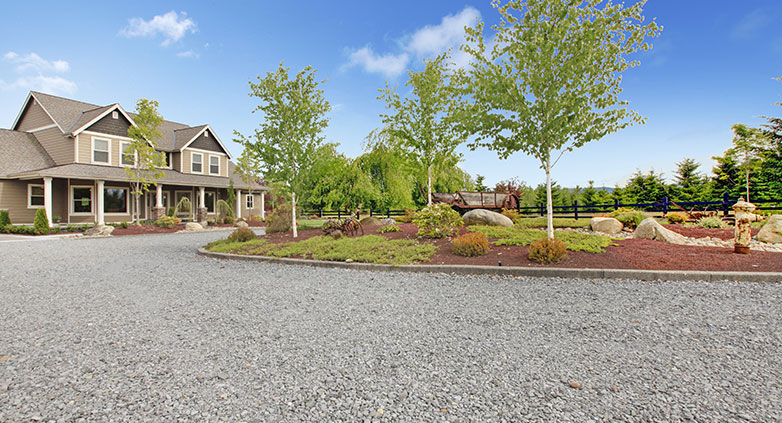Oil and Stone Driveway – Embracing Time-Tested Elegance
In today’s world, homeowners are often overwhelmed by the multitude of choices available for driveway surfaces. These range from traditional options like loose gravel to modern alternatives such as resin-based solutions. However, amidst this wide array of choices, the oil and stone driveway stands out as a unique and appealing option for those seeking an economical and low-maintenance solution.
The oil and stone driveway, also known as a gravel drive surfaced with asphalt (bituminous oil) and loose stone, offers a rustic yet sophisticated appearance. This method involves laying fresh asphalt and then embedding loose stones into it using a heavy roller. If this process sounds familiar, it’s because oil and stone surfacing has a rich history. Originating in England during the 1830s, this technique was initially used with coal tar before the advent of crude oil distillation. As automobiles began to replace horse-drawn carriages, this surfacing method gained popularity across the USA, England, Australia, and New Zealand. Known by various names such as “tar and chip,” “chip-seal,” and “macadam” (a term you might encounter in old British spy novels), oil and stone driveways have stood the test of time as a reliable and cost-effective surfacing option.
To fully grasp the essence of this driveway style, a dive into its historical roots is essential, along with a comparison to other similar surfacing techniques. Our comprehensive guide will illuminate the unique aspects of this enduring option, enabling you to make a well-informed choice for your property. Keep an eye out for our thorough analysis, where we blend historical insights with modern practicality to explore this traditional yet practical surfacing method.
What Exactly Is An Oil And Stone Driveway Made From?

A driveway with both aesthetic and practical appeal, commonly known as an oil and stone surface, primarily uses bituminous oil as a binder. Delving into the distillation of crude oil reveals the origin of this component. During this process, crude oil is separated into various fractions based on the weight of its hydrocarbons. The gases move to the top, while intermediate-weight hydrocarbons like fuel oil and diesel are in the middle. The heaviest, bituminous oil, settles at the bottom of the distillation column.
Bituminous Oil vs. Asphalt: Understanding Their Roles in Driveway Surfaces
Often confused with asphalt, bituminous oil is a thick, viscous material derived directly from crude oil distillation. In contrast, asphalt results from blending bitumen with aggregates such as gravel and sand. This mixture, heated to a malleable state, is commonly used for laying driveways and roads.
Texture and Durability: Key Attributes of Different Driveway Materials
The method of application and the resulting texture set these two materials apart. Asphalt driveways, known for their uniform black color and smoothness, are a staple in the United States. They require a sealant to maintain their integrity due to their relative brittleness. Conversely, driveways utilizing bituminous oil and stone offer a unique aesthetic and a durable surface without the need for frequent sealing. This distinction is important for homeowners looking for a driveway that combines visual charm with functionality.
Differentiating Between Asphalt, Bitumen, and Tar in Driveway Surfacing
The Stones Used in Oil and Gravel Driveways
The stone used in this type of driveway can be almost any stone depending on the desired look and feel. Popular options include granite, flint, magnesian limestone, slate, or river rock.10 mm is the most popular average stone size, but the size can vary from about 5 mm up to 20 mm. Stones larger than 20 mm bind less effectively and are more likely to become loose over time.
A seminal study of oil and stone surfacing conducted in New Zealand in 1935 established that the ideal ratio of oil to chips should result in the bitumen reaching 2/3 the height of the average stone and that roughly cubical stones are preferable to flat or round rocks.
These basic principles are still the gold standard today.
Advantages of Oil and Stone Driveways

The oil and stone driveway, a charming and practical option, often gets overlooked by homeowners for two common misconceptions:
- The assumption that it only offers a monotonous black stone appearance reminiscent of old backroads.
- The belief that newer driveway materials must inherently offer better solutions.
Contrary to these beliefs, modern oil and stone driveways offer a rich diversity in both color and texture. This versatility enables homeowners to select a driveway that not only complements their home’s exterior but also reflects their personal style. Far from being a relic of the past, these driveways have evolved to suit contemporary tastes and requirements.
Additionally, this driveway type stands out as one of the most economically advantageous and visually striking options available. Its blend of long-lasting quality and aesthetic adaptability makes it an intelligent selection for homeowners looking to harmonize traditional charm with contemporary style in their property’s landscaping.
Aesthetics
The modern oil and stone driveway offers extensive customization, allowing homeowners to select the color and size of the stones for the top layer. This flexibility in design ensures that the driveway can seamlessly integrate with the home’s exterior, existing landscaping, or the natural stone in the surroundings. The result is a driveway that not only complements the property but also enhances its overall curb appeal.
Further adding to their aesthetic appeal, these driveways strike a charming balance with their country house feel, positioned perfectly between the simplicity of gravel and the more industrial appearance of black asphalt or concrete. The inclusion of paver borders offers a functional and stylish upgrade, helping to maintain the driveway’s neat appearance by keeping loose stones in place and protecting adjacent grass and plant areas.
The installation cost
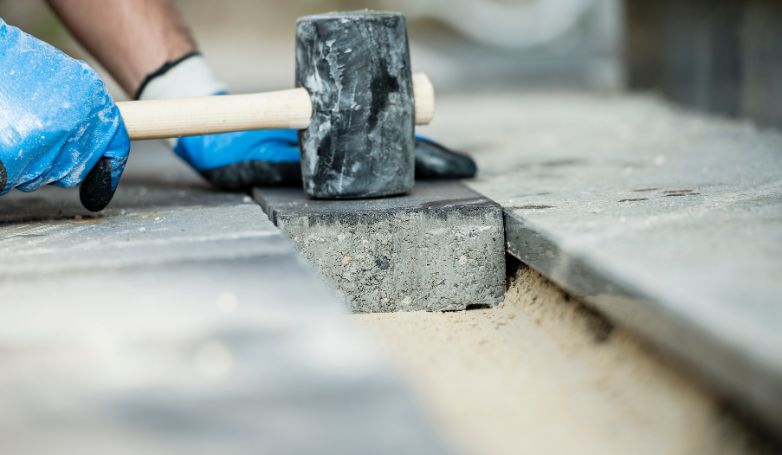
The cost-effectiveness of oil and stone driveways is partly due to their long-standing history and the simplicity of the materials used. The main components – bituminous oil and stone – are not only abundant but also don’t require specialized equipment for storage, transport, or installation.
While these driveways are more costly than basic gravel options, they are significantly more affordable than asphalt driveways. They offer a cost-effective alternative, approximately half the price of installing concrete or paver driveways. This makes them an attractive choice for homeowners seeking a balance between affordability and aesthetic appeal.
Ease of Installation
Although installing an oil and stone driveway is not a typical do-it-yourself project, finding a qualified professional for the job is straightforward. The installation process is relatively quick and less complex compared to other driveway materials. This ease of installation contributes to their cost-effectiveness and makes them a practical choice for homeowners who want a durable and attractive driveway without enduring a lengthy or disruptive installation process.
The Layers
As with any drive, your contractor will begin by excavating, grading, and compacting the soil. Then he will deposit a layer of gravel. It is crucial to resolve any slope or drainage issues before installation.
A driveway is only as good as the surface beneath because oil and stone follow the underlying layers’ contours.
If you are installing over a previously existing driveway, ensure that the substrate is not severely cracked and no potholes are present. Oil and stone cannot be used to repair those kinds of defects.
The contractor will then spay a ¼ inch layer of bitumen heated to 190º F over the gravel. Your contractor will need to schedule the spraying on a dry day with an ambient temperature of at least 55º F.
While the asphalt is still hot, the contractor dumps loose stone on top of the bitumen. A crew will then spread the stones by hand using wooden lutes. They will need to do this quickly since bitumen hardens relatively fast.
A special-purpose roller truck or hand-roller presses the loose stones into the hot asphalt, essentially gluing the loose stones together with bitumen. It’s essential to use a roller with rubber wheels. The heavy steel rollers used in highway construction will crush the stones, which radically changes the aesthetics.
The Double-Chip Seal
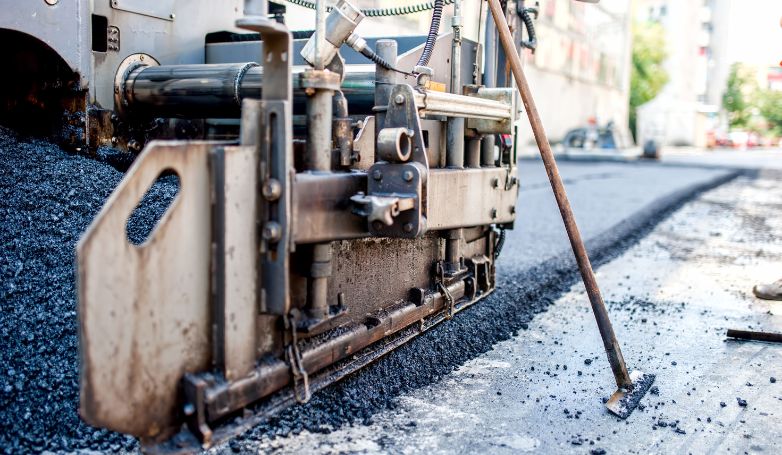
Some homeowners opt to do a second layer of stone, called a double-chip seal. There is also a process called a “cape-seal,” in which a standard oil and stone driveway is covered by a slurry comprised of bituminous oil, fine aggregate, water, and cement.
A cape seal will extend a driveway life by as much as 50%. However, the look is much closer to that of asphalt, which may not be desirable to many homeowners.
Another benefit of a driveway is it may be installed over an existing drive, provided the current driveway is in reasonable condition.
Ease of Maintenance
Once you’ve laid down your driveway, there’s little maintenance required.
Unlike asphalt driveways, oil and stone don’t need to be sealed (or resealed on an annual basis.) During the warm days of Summer, the asphalt naturally softens a bit and effectively reseals itself.
The stones due tend to wander, especially in heavy rains. In the Spring, the homeowner may need to rake up the loose stones and redistribute them.
During warmer days, the loose respread stones are pressed back into the asphalt by the owner’s cars’ normal weight.
Some people opt to spray a sealant to “lock’ the stones in place. This is called a fog seal or “enrichment.”
Several higher-tech options are available for oil and stone driveways using either polymer-modified bitumen or an asphalt “emulsion” (which results from blending liquid asphalt, surfactants, and water).
These modified binding materials reduce the release of volatile organic compounds, may help water resistance, and reduce cracking.
However, these higher-tech options are not available from most contractors. They also may add substantially to the cost and do not dramatically increase the driveway’s lifetime.
A typical driveway made with oil and stone will last for seven to ten years with little or no maintenance.
Safety

These types of driveways present a coarse surface. Unlike concrete, the homeowner needn’t worry about the drive becoming slippery when wet or icy.
You can safely take the trash down the drive to the curb, and getting up the drive in cars is rarely a problem.
On the flip side, the surface is rough, and some of the stones are sharp. Falls on the rough stone can result in cuts and scrapes. If you have kids, they’ll want to do things like skating or skateboarding someplace else.
Eco-Friendly
A final plus is that they are made entirely from natural materials. Unlike asphalt, the bituminous oil used in oil and stone drives is an all-natural petroleum byproduct. Of course, stones are as natural as it gets.
If you are doing new construction, you may even have the option of recycling the material removed from your foundation for your driveway stone.
These types of driveways do not retain heat from the sun as much as many other driveway surfaces, which can be a real boon to surrounding landscaping.
Potential Disadvantages of an Oil and Stone Driveway
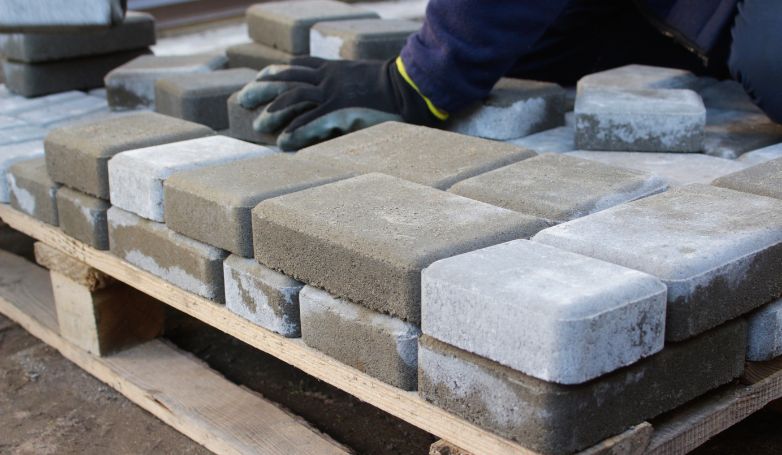
Certain drawbacks may need consideration when opting for an oil and stone driveway; it’s essential to be mindful of the following factors:
Runoff and Drainage
Oil and stone driveways can be problematic in areas with heavy rainfall or flooding. If your driveway is on a steep incline or in a location prone to water accumulation, the stones can easily become loose and gather in runoff areas. This often leads to uneven surfaces and bare patches on the driveway. Additionally, such conditions can cause erosion under the driveway, compromising its structural integrity over time. Proper drainage solutions must be implemented during installation to mitigate these issues. Regular maintenance, such as checking for and repairing erosion, can also help prolong the driveway’s lifespan.
Snow Plowing
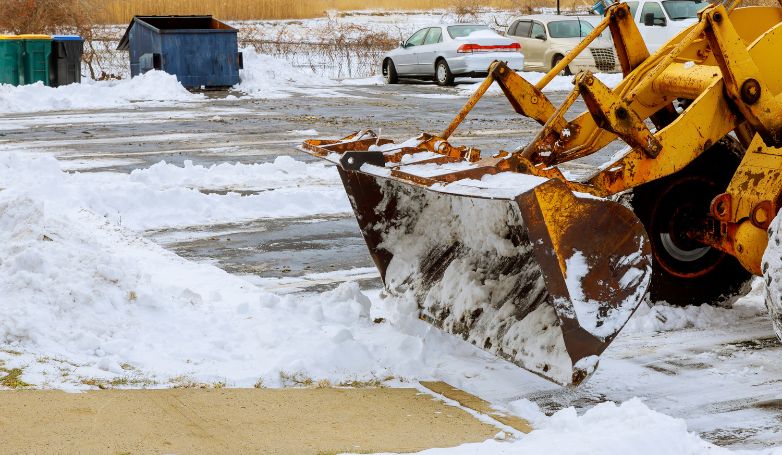
Snow management on oil and stone driveways requires careful strategy. If the snowplow blade is set too low, it can scrape and dislodge the stones, leading to an uneven surface. It’s advised to set the snowplow shoes about half an inch above the surface and leave about an inch of snow for traction. Furthermore, frequent snow plowing can gradually displace stones over time, necessitating occasional replenishment. Using a snowblower or a broom for lighter snowfalls can be a gentler alternative to plowing. In areas with heavy snowfall, installing markers along the driveway edges can help guide snow removal without disturbing the stones.
Local Ordinances
Before installing an oil and stone driveway, it’s essential to check local ordinances, as they may be prohibited in some areas. These restrictions could stem from various reasons, such as environmental concerns, aesthetic standards set by the community, or specific maintenance requirements. Non-compliance with these regulations can lead to penalties, including fines or the need to reconstruct the driveway using approved materials. Additionally, in locales with stringent stormwater management rules, such driveways might necessitate special construction methods to meet compliance. Consulting with local authorities or a knowledgeable contractor is recommended to ensure you’re fully informed about these regulations.
Requires a Qualified Contractor
Installing an oil and stone driveway is not a DIY project and requires a skilled contractor. Finding an experienced professional who can demonstrate a substantial portfolio of successful projects is key. Ideally, you should find contractors who have completed projects in your area so you can visit and speak to the owners. It’s also important to ensure the contractor is licensed, insured, and familiar with local building codes and regulations.
Checking online reviews and asking for references can offer additional insights into their reliability and quality of work. Lastly, a good contractor should be able to provide a clear and detailed quote, outlining the costs, timeline, and scope of the project.
Oil and Stone Driveway Cost
| Cost Component | Price Range per Square Foot |
|---|---|
| Materials (Stone) | $10 – $50 |
| Materials (Bituminous Oil) | $1 – $5 |
| Labor and Installation | $2 – $8 |
| Preparation and Additional Work | $5 – $15 |
| Total Cost Estimate (Basic) | $12 – $30 |
| Total Cost Estimate (High-End) | $30 – $70 |
When evaluating options for a new driveway, cost is typically a significant consideration for homeowners. Driveways using a combination of bituminous oil and stone are often recognized for their balance of rustic appeal and lasting quality, presenting a budget-friendly alternative to other materials. Being aware of the different cost factors associated with this type of driveway installation is essential in making a well-informed choice.
Material Costs
The primary components of an oil and stone driveway are bituminous oil and the chosen stones. The cost of these materials can vary depending on the type and quality of the stone and the regional availability of bituminous oil. Higher-quality or unique stone types can increase the cost, while more common stone varieties are typically more budget-friendly.
Labor and Installation Charges
The cost of labor is another significant component. This varies depending on your location and the complexity of the driveway installation. Labor costs can be influenced by factors such as the size of the driveway, site accessibility, and the need for any additional groundwork or drainage solutions.
Preparation and Additional Work
Preparation work, such as removing an existing driveway, grading, or adding a base layer, can add to the overall cost. If your property requires significant preparation or landscaping work to accommodate the driveway, these costs can accumulate quickly.
Long-term Maintenance

While oil and stone driveways are low maintenance, occasional upkeep such as re-spreading loose stones or addressing drainage issues may be necessary. These long-term maintenance costs are generally low compared to other materials but should be factored into the overall budget.
Regional Variations
Costs can also vary significantly based on your geographic location. Factors like local labor rates, material availability, and even weather conditions can influence the total cost of an oil and stone driveway in your area.
Estimating Your Driveway Cost
To get an accurate estimate for your oil and stone driveway, it’s advisable to consult with several local contractors. They can provide detailed quotes based on your specific requirements, property layout, and local cost factors. Comparing these estimates will give you a clearer idea of the potential investment and help you budget accordingly for your new driveway.
Overall Recommendation and Conclusion
When selecting a driveway material, this particular style offers versatility and suitability for various property types. However, the overall aesthetic of your property is a key consideration. These driveways tend to have a rustic charm, but the wide range of stone colors and textures available allows for significant customization. This flexibility enables you to match the driveway with your home’s style, be it modern, traditional, or something in between.
If you’re contemplating installing a new driveway or thinking about rejuvenating your existing one, it’s worth exploring the oil and stone option. Its combination of aesthetic appeal, customization possibilities, and practical benefits makes it a strong contender in the world of driveway materials. With the right design choices, an oil and stone driveway can not only enhance the curb appeal of your home but also serve as a durable and cost-effective solution for your driveway needs.

